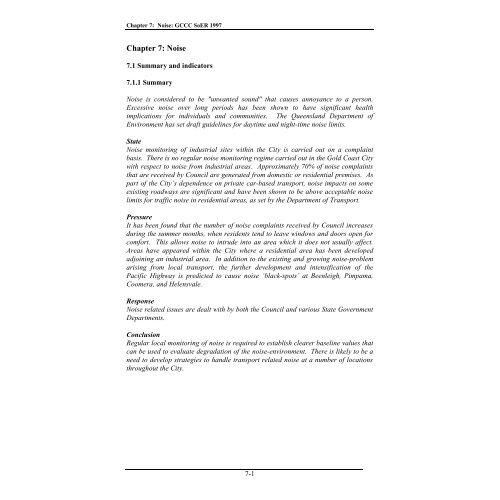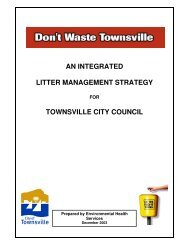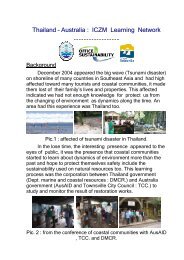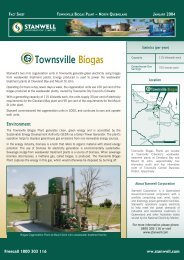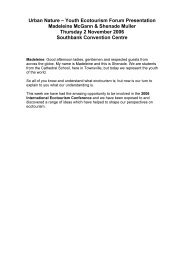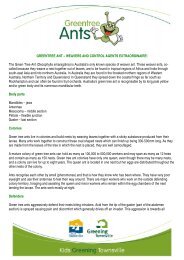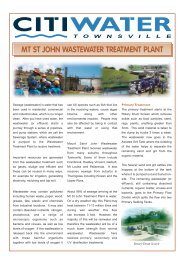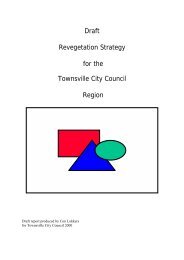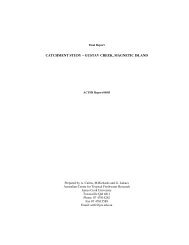Chapter 7: Noise - Townsville State of the Environment Report
Chapter 7: Noise - Townsville State of the Environment Report
Chapter 7: Noise - Townsville State of the Environment Report
You also want an ePaper? Increase the reach of your titles
YUMPU automatically turns print PDFs into web optimized ePapers that Google loves.
<strong>Chapter</strong> 7: <strong>Noise</strong>: GCCC SoER 1997<br />
<strong>Chapter</strong> 7: <strong>Noise</strong><br />
7.1 Summary and indicators<br />
7.1.1 Summary<br />
<strong>Noise</strong> is considered to be "unwanted sound" that causes annoyance to a person.<br />
Excessive noise over long periods has been shown to have significant health<br />
implications for individuals and communities. The Queensland Department <strong>of</strong><br />
<strong>Environment</strong> has set draft guidelines for daytime and night-time noise limits.<br />
<strong>State</strong><br />
<strong>Noise</strong> monitoring <strong>of</strong> industrial sites within <strong>the</strong> City is carried out on a complaint<br />
basis. There is no regular noise monitoring regime carried out in <strong>the</strong> Gold Coast City<br />
with respect to noise from industrial areas. Approximately 70% <strong>of</strong> noise complaints<br />
that are received by Council are generated from domestic or residential premises. As<br />
part <strong>of</strong> <strong>the</strong> City’s dependence on private car-based transport, noise impacts on some<br />
existing roadways are significant and have been shown to be above acceptable noise<br />
limits for traffic noise in residential areas, as set by <strong>the</strong> Department <strong>of</strong> Transport.<br />
Pressure<br />
It has been found that <strong>the</strong> number <strong>of</strong> noise complaints received by Council increases<br />
during <strong>the</strong> summer months, when residents tend to leave windows and doors open for<br />
comfort. This allows noise to intrude into an area which it does not usually affect.<br />
Areas have appeared within <strong>the</strong> City where a residential area has been developed<br />
adjoining an industrial area. In addition to <strong>the</strong> existing and growing noise-problem<br />
arising from local transport, <strong>the</strong> fur<strong>the</strong>r development and intensification <strong>of</strong> <strong>the</strong><br />
Pacific Highway is predicted to cause noise ‘black-spots’ at Beenleigh, Pimpama,<br />
Coomera, and Helensvale.<br />
Response<br />
<strong>Noise</strong> related issues are dealt with by both <strong>the</strong> Council and various <strong>State</strong> Government<br />
Departments.<br />
Conclusion<br />
Regular local monitoring <strong>of</strong> noise is required to establish clearer baseline values that<br />
can be used to evaluate degradation <strong>of</strong> <strong>the</strong> noise-environment. There is likely to be a<br />
need to develop strategies to handle transport related noise at a number <strong>of</strong> locations<br />
throughout <strong>the</strong> City.<br />
7-1
<strong>Chapter</strong> 7: <strong>Noise</strong>: GCCC SoER 1997<br />
7.1.2 Indicators<br />
Sub-<strong>the</strong>me<br />
<strong>State</strong>-<br />
⇒ <strong>Noise</strong> from transport<br />
<strong>State</strong>-<br />
⇒ Monitored readings from<br />
industrial sites and point<br />
sources<br />
<strong>State</strong>-<br />
⇒ <strong>Noise</strong> from o<strong>the</strong>r sources<br />
<strong>State</strong><br />
⇒ transport<br />
Pressure-<br />
⇒ Industrial sources<br />
Pressure-<br />
⇒ residential sources<br />
Current Responses-<br />
⇒ <strong>State</strong> or Council codes<br />
Indicators<br />
Monitored ambient noise readings for major roads (by time <strong>of</strong> day)<br />
Monitored readings for major industrial sites and point sources<br />
<strong>Noise</strong> from ERAs<br />
Workplace noise levels<br />
Complaints to council and DEH<br />
Traffic volume and location<br />
Areas where codes apply<br />
7.2 Introduction<br />
<strong>Noise</strong> is considered to be "unwanted sound" that causes annoyance to a person.<br />
Excessive noise over long periods has been shown to have significant health<br />
implications for individuals and communities.<br />
In <strong>the</strong> regulation and control <strong>of</strong> noise in <strong>the</strong> community, noise can be divided into two<br />
different areas, depending on where <strong>the</strong> noise is generated. These groups are known<br />
as residential and commercial/industrial areas.<br />
<strong>Noise</strong> that originates from ei<strong>the</strong>r one <strong>of</strong> <strong>the</strong>se areas may vary greatly from <strong>the</strong> type <strong>of</strong><br />
noise created in <strong>the</strong> o<strong>the</strong>r, due to <strong>the</strong> varying types <strong>of</strong> activities that are carried out in<br />
each <strong>of</strong> <strong>the</strong> areas.<br />
Residential noise results from premises in a residential area affecting one ano<strong>the</strong>r.<br />
Examples <strong>of</strong> noise that can originate from residences and cause a problem include<br />
noise from power tools, pool filters, air conditioners, lawn mowers, toilet exhausts,<br />
barking dogs and behavioural noise (music, rowdy behaviour).<br />
Industrial and commercial premises create different types <strong>of</strong> noise than that <strong>of</strong><br />
residential areas and as such, can affect <strong>the</strong>ir neighbours differently. Examples <strong>of</strong> noise<br />
generated from industrial/commercial premises include noise from heavy machinery,<br />
compressors, refrigeration motors, truck deliveries, exhaust fans, amplified music,<br />
banging and grinding.<br />
7-2
<strong>Chapter</strong> 7: <strong>Noise</strong>: GCCC SoER 1997<br />
7.3 <strong>State</strong><br />
The Queensland Department <strong>of</strong> <strong>Environment</strong> has set draft guidelines for daytime and<br />
night-time noise limits as shown below:<br />
• 55 dB(A) (L eg (8 hour) night-time (22:00 - 06:00)): This is <strong>the</strong> equivalent<br />
continuous noise exposure level for <strong>the</strong> specified period.<br />
• 63 dB(A): (L 10 (18 hour) night-time (06:00 - 00:00)): This is <strong>the</strong> ‘A-frequency<br />
range’ weighted noise level that is allowed to be exceed for only 10% <strong>of</strong> <strong>the</strong><br />
specified time period. The ‘A frequency range’ approximates that <strong>of</strong> <strong>the</strong> human ear.<br />
L eg and L 10 are thresholds which refer to different average noise levels, <strong>of</strong> different<br />
duration, at different times <strong>of</strong> <strong>the</strong> day.<br />
<strong>Noise</strong> monitoring <strong>of</strong> industrial sites within <strong>the</strong> City is carried out on a complaint basis.<br />
There is no regular noise monitoring regime carried out in <strong>the</strong> Gold Coast City with<br />
respect to noise from industrial areas. Therefore, all noise measurements that <strong>the</strong><br />
Council has obtained are as a result <strong>of</strong> complaints and consequently not all industrial<br />
areas have been monitored.<br />
Examples <strong>of</strong> ambient background readings measured within some <strong>of</strong> <strong>the</strong> City's<br />
industrial areas between 7am to 10pm are shown in Table 7.1.<br />
Table 7.1: Ambient background noise readings (7am-10pm) from selected<br />
industrial areas <strong>of</strong> <strong>the</strong> City <strong>of</strong> Gold Coast<br />
Location<br />
Background noise reading<br />
(dB(A))<br />
Labrador (Brisbane Rd) 60<br />
Molendinar (Industrial Ave) 55<br />
Miami (Gold Coast Highway) 50<br />
Yatala (Burnside Rd) 50<br />
<strong>Environment</strong>ally Relevant Activities (ERAs) licensed by Council are usually located<br />
within commercial/industrial areas and as such, create <strong>the</strong> same types <strong>of</strong> noise that are<br />
mentioned above. In 1995/96 <strong>the</strong>re were 44 noise complaints received and actioned<br />
that related to ERAs.<br />
Approximately 70% <strong>of</strong> noise complaints that are received by Council are generated<br />
from domestic or residential premises. Officers from Council’s Health and Regulatory<br />
Services Branch use <strong>the</strong> Council's Local Laws to solve complaints regarding lawn<br />
mowers, air conditioners and barking dogs, whilst <strong>the</strong> <strong>Noise</strong> Abatement Regulations<br />
1979 are used to deal with noise complaints regarding pool filters.<br />
All previous information supplied regarding noise has dealt with <strong>of</strong>f-site effects <strong>of</strong><br />
noise. Excessive noise that affects <strong>the</strong> employees <strong>of</strong> a workplace and is generated by<br />
that same workplace is regulated by <strong>the</strong> Division <strong>of</strong> Workplace Health & Safety,<br />
Queensland Government<br />
7-3
<strong>Chapter</strong> 7: <strong>Noise</strong>: GCCC SoER 1997<br />
At this stage, <strong>the</strong> retrieval <strong>of</strong> data with respect to <strong>the</strong> number, type and location <strong>of</strong><br />
noise complaints (Non ERA) is not possible, however, a revised reporting format has<br />
been introduced to allow this by <strong>the</strong> Department <strong>of</strong> <strong>Environment</strong>.<br />
The development <strong>of</strong> road-based transport systems has been vital to <strong>the</strong> economy <strong>of</strong> <strong>the</strong><br />
Gold Coast. This situation is likely to continue for <strong>the</strong> near future. For example,<br />
without such development <strong>the</strong> average trip time will more than treble from today’s 13<br />
minutes for <strong>the</strong> average trip <strong>of</strong> 9km to around 75 minutes for a trip <strong>of</strong> 14km. Such<br />
congestion will have impacts on amenity, noise and air quality on <strong>the</strong> Gold Coast.<br />
As part <strong>of</strong> <strong>the</strong> City’s dependence on private car-based transport, noise impacts on<br />
some existing roadways associated with <strong>the</strong> Pacific Highway are significant and have<br />
been shown to be above <strong>the</strong> Department <strong>of</strong> Transport noise limits. These were at:<br />
• Dublin Drive, Eagleby;<br />
• The Esplanade, Coomera;<br />
• The Gardenvale Caravan Park (Oxenford);<br />
• Entrance Road (Gaven);<br />
• Arjuna Way (Nerang);<br />
• Parkridge Drive (Nerang);<br />
• Nerang Street (Nerang);<br />
• and Cayuga Street (Nerang).<br />
The Main Roads Department has also conducted a noise modelling study into noise<br />
levels associated with o<strong>the</strong>r Gold Coast roads and predicts that approximately 4000<br />
residences are currently affected by excessive noise. Figure 7.1 shows <strong>the</strong> location <strong>of</strong><br />
noise affected residences along major Gold Coast roads.<br />
Ano<strong>the</strong>r area affected by transport related noise is <strong>the</strong> Sou<strong>the</strong>rn Gold Coast<br />
surrounding <strong>the</strong> Coolangatta Airport. Problems associated with aircraft noise could<br />
increase if <strong>the</strong> airport traffic is increased and International flights come directly to<br />
Coolangatta.<br />
7-4
<strong>Chapter</strong> 7: <strong>Noise</strong>: GCCC SoER 1997<br />
Figure 7.1: Residences exposed to road traffic noise levels above 68 dB(A) in<br />
1997. (Source: Huson and Assoc. 1997)<br />
7-5
<strong>Chapter</strong> 7: <strong>Noise</strong>: GCCC SoER 1997<br />
7.4 Pressure<br />
It has been found that <strong>the</strong> number <strong>of</strong> noise complaints received by Council increases<br />
during <strong>the</strong> summer months, when residents tend to leave windows and doors open for<br />
comfort. This allows noise to intrude into an area which it does not usually affect.<br />
Areas have appeared within <strong>the</strong> City where a residential area has been developed<br />
adjoining an industrial area. This creates problems, due to <strong>the</strong> loud nature <strong>of</strong> activities<br />
carried out in an industrial area, affecting <strong>the</strong> quiet <strong>of</strong> <strong>the</strong> adjoining residential area. In<br />
<strong>the</strong>se situations, both parties believe that <strong>the</strong>y have conflicting rights.<br />
Suitable buffer zones may prevent this situation from arising. This issue also relates to<br />
<strong>the</strong> Gold Coast Airport, <strong>the</strong> adjoining residential areas and those in <strong>the</strong> flight path.<br />
In addition to this <strong>the</strong> fur<strong>the</strong>r development and intensification <strong>of</strong> <strong>the</strong> Pacific Highway is<br />
predicted to cause noise ‘black-spots’ at Beenleigh, Pimpama, Coomera, and<br />
Helensvale (Rust PPK 1997). These areas correspond with <strong>the</strong> ‘air black-spots’ shown<br />
in Figure 4.1. Huson and Assoc (1997) also predict that <strong>the</strong> number <strong>of</strong> noise affected<br />
residences along <strong>State</strong>-controlled Gold Coast roads will increase to over 7000 by <strong>the</strong><br />
year 2007.<br />
These impacts are driven by growth <strong>of</strong> vehicle usage in <strong>the</strong> City. The Gold Coast has<br />
one <strong>of</strong> <strong>the</strong> highest rates <strong>of</strong> growth for new residences and has a high ownership <strong>of</strong><br />
vehicles per capita. These facts are compounded by <strong>the</strong> high use <strong>of</strong> cars for transport<br />
in <strong>the</strong> Gold Coast and <strong>the</strong> low vehicle occupancy rate. The result <strong>of</strong> this is a significant<br />
noise problem from transport in <strong>the</strong> City.<br />
7.5 Response<br />
There is a range <strong>of</strong> legislation used by Council’s Health and Regulatory Services<br />
Branch to control <strong>the</strong> levels <strong>of</strong> noise generated by certain premises. The legislation<br />
used by Health and Regulatory Services Branch includes:<br />
• The <strong>Environment</strong>al Protection Act 1994 - Devolved environmentally relevant<br />
activities (ERAs).<br />
• The <strong>Noise</strong> Abatement Act 1978 - All commercial/industrial premises in <strong>the</strong> former<br />
Gold Coast City Council area only (explained below).<br />
• The <strong>Noise</strong> Abatement Regulation 1979 - Swimming pool equipment.<br />
• Gold Coast City Council Local Laws - All domestic noise issues.<br />
O<strong>the</strong>r noises not included above that are generated within <strong>the</strong> City are regulated by<br />
o<strong>the</strong>r <strong>State</strong> Authorities, including <strong>the</strong> Department <strong>of</strong> <strong>Environment</strong>, Queensland Police<br />
Service and <strong>the</strong> Licensing Commission.<br />
Complaints received regarding commercial/industrial (non ERAs) are only investigated<br />
within <strong>the</strong> former Gold Coast City, as <strong>the</strong> responsibility for its control was devolved to<br />
<strong>the</strong> former Council under <strong>the</strong> <strong>Noise</strong> Abatement Act 1978. In <strong>the</strong> former Albert Shire,<br />
all commercial and industrial premises (non ERAs) are regulated by <strong>the</strong> <strong>State</strong><br />
Department <strong>of</strong> <strong>Environment</strong>.<br />
7-6
<strong>Chapter</strong> 7: <strong>Noise</strong>: GCCC SoER 1997<br />
Complaints from commercial and industrial (including ERA) premises concern mainly<br />
machinery and tool noise, eg, compressors, refrigeration motors, grinders.<br />
The Main Roads Department proposes to spend $8M on noise abatement along <strong>State</strong>controlled<br />
Gold Coast roads by <strong>the</strong> year 2002. They will also undertake community<br />
consultation on this issue and will cooperate with <strong>the</strong> Gold Coast City Council to<br />
establish effective planning controls (Huson and Assoc. 1997)<br />
7.6 Conclusions and possible future responses<br />
<strong>Noise</strong> is not an acute issue for most <strong>of</strong> <strong>the</strong> City <strong>of</strong> Gold Coast. However where it is, it<br />
is mostly associated with pets, light industry and transport and to some extend aircraft.<br />
In some areas, particularly those adjacent to major roads and <strong>the</strong> Pacific Highway,<br />
problems associated with traffic noise are likely to increase.<br />
The Gold Coast City Council is looking to locate permanent noise monitoring sites<br />
throughout <strong>the</strong> City. These devices will provide more reliable data and will enable a<br />
more consistent approach to noise regulation. This monitoring would be in<br />
conjunction with <strong>the</strong> development <strong>of</strong> <strong>the</strong> upgraded Pacific Highway and will include<br />
<strong>the</strong> linking <strong>of</strong> <strong>the</strong> upgrade to <strong>the</strong> new Town Plan so that impacts from noise can be<br />
reduced. These data would <strong>the</strong>n allow noise contours to be developed that may assist<br />
in <strong>the</strong> design and assessment <strong>of</strong> development proposals.<br />
7.6 References<br />
Huson and Assoc. (1997) South Coast -Hinterland District Road Traffic <strong>Noise</strong><br />
management Strategy, Main Roads Department, Queensland Government<br />
Rust PPK (1996) Pacific Motorway Review <strong>of</strong> <strong>Environment</strong>al Factors: Human,<br />
Natural and Economic, Main Roads Queensland Government<br />
7-7


